Stevens Avenue Project
:
Speeding and Pedestrian
Accidents
"The common thread with accidents seems to be the turning, therefore, slowing driver OR the stopping driver (usually to turn; in a few cases, stopping for pedestrians)." : Paula Craighead
Where to start is the big problem. For simplicity's sake, let's say that the supporters lied. They did.
Supposedly, speeding was causing a lot of accidents and pedestrians accidents on Stevens Avenue. “This is why the SAP was started, and needed”.
This is false: What got the whole project started was the statement: “The common thread with accidents seems to be the turning, therefore, slowing driver OR the stopping driver (usually to turn; in a few cases, stopping for pedestrians).”; this in a letter from Paula Craighead, the initiator of the SAP, in a letter to George Flaherty, head of Portland DPW, on Feb. 6, 1992, published in the 1994 PACTS Phase I Report Technical Supplement, page 2.
About a year later,
speeding was somehow the
alleged cause, but how that radical change came about has never been
explained by the city. Something had to be changed to make sure the
project made sense to the public somehow, and then got funded.
Speeding sounds good ....and
dangerous.
Just 2 ½ % of all the vehicle accidents presented for the years 1988-1993 were caused by “excessive” speed. This is 2 accidents out of 62, as determined by the city, and 7 accidents out of 275 (still 2 ½%) for the years 1993-1997. One of those involved an ambulance, so its "usefulness" to support this project is sketchy.
The other 97.5% of accidents involved driver inattention mostly, failure to yield, and turning incidents. BUT, those don't sound as dangerous and sexy as speeding, so supporters ignored those.
Five pedestrian accidents (average one per year) were presented as “speeding” evidence. Four of those took place at under 5 MPH; the fifth took place at under 20 MPH. This is not speeding. This alleged “speeding problem” doesn’t get mentioned anymore.
None of what the City presented as "evidence" supported an "accident
problem".
None of them
took place at Longfellow school and none involved speeding:
Pedestrian accidents:
from
1993
PACTS Phase I Report Technical Supplement
Click on page for enlarged version
| 12/18/87 | 2/8/90 | 12/20/91 | 10/6/89 | 2/24/90 |
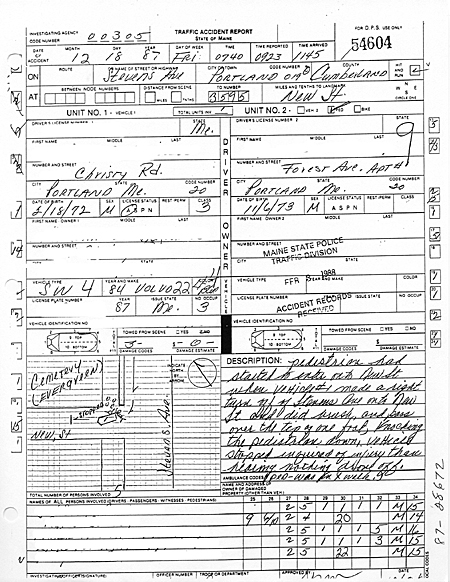 |
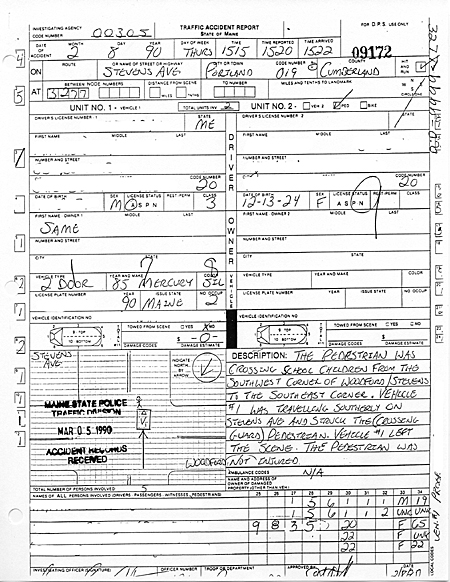 |
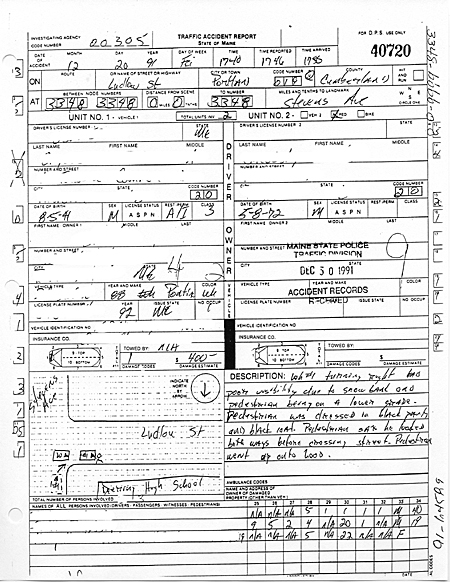 |
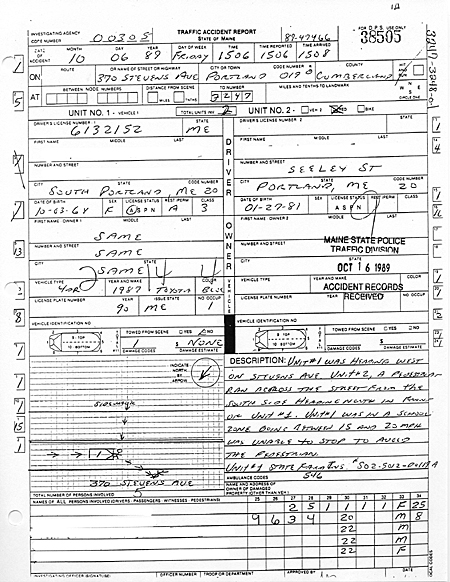 |
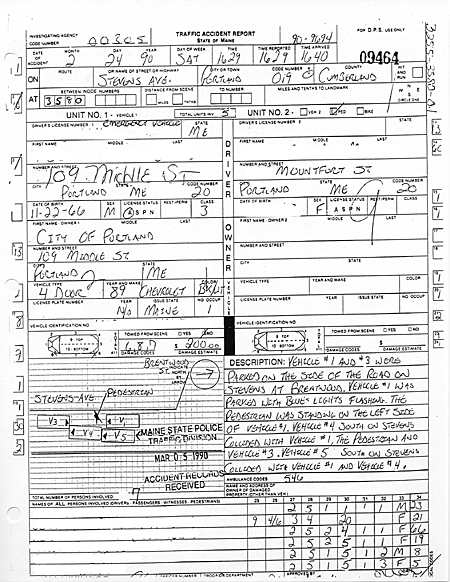 |
12/18/87 : At 740am a car turned right onto New
St., and brushed a pedestrian. It stopped,
asked for injuries, and hearing of none, continued on.
02/08/90 : At 315pm a crossing guard (age 66)
was struck at the intersection of Woodfords
and
Stevens.
No injuries.
12/20/91: At 540pm in the dark a car turning
right onto Ludlow St. struck a pedestrian
dressed
in black at a lower grade and hidden by a snow bank. Pedestrian
wound
up on hood, but with no injuries.
10/06/89: At 306pm an 8-year-old boy ran
across Stevens in front of Deering HS to avoid a
bully that was chasing him. He was struck, thrown onto the hood, and
thence to the
ground, suffering scrapes and bruises. Driver was going 15-20 mph.
02/04/90: At 429pm on a very
slippery snowy day, a policeman was struck while attending to
an accident across from Video Jam in Deering Cemter. A woman stepped on her
brakes
coming up
to
the first accident, and slid into Officer Coons, brushing him,
and
pushing the second car into the first car. Total damage to all three
cars was
$200.00 .
PLEASE NOTICE: This is the
officially presented "evidence" of a speeding problem in
the
1993
Phase I Report, and maintained for the
1998 Final Monitoring Report.
THERE IS NONE
These accidents all took place early or late in the day, and all but one took place at slow speeds on slippery roads. The little boy ran into the road. Traffic calming does not prevent any of this .
I took my son to Longfellow every school day morning for 5 years, and picked him up every afternoon, so I think I have some idea of what the situation was.
Vehicles were supposedly speeding in front of Longfellow School, doing an average of 28 MPH, while children were going to and from the school.
No, they weren’t . What the PACTS Phase 1 Report said was that cars were doing an average of 28 MPH in the Longfellow School zone. That includes both ends of the zone....
There was also a bit of hoopla about speeding at the time too: some
disinformation:
Supposedly there were cars doing 55MPH on Stevens, threatening children
on their way to school! This had to be
researched, and the critics were right! - to an extent.
Way back in the supplement to the Phase I
Report, a whole separate volume, there was
a record of a vehicle doing 55 on Stevens. At 2:30 AM.
School at the time started at 9 AM, so it seems a bit unlikely that
parents were sending their kids to school at 2:30 in the morning to hang
out in the dark for 6-1/2 hours.
Sounds bad though doesn't it?
The next question I had was one of wondering who would be going that fast at that time of night? Police? Ambulances? And why not? Does anybody want a slow emergency response?
Next: VEHICLE ACCIDENTS 1993